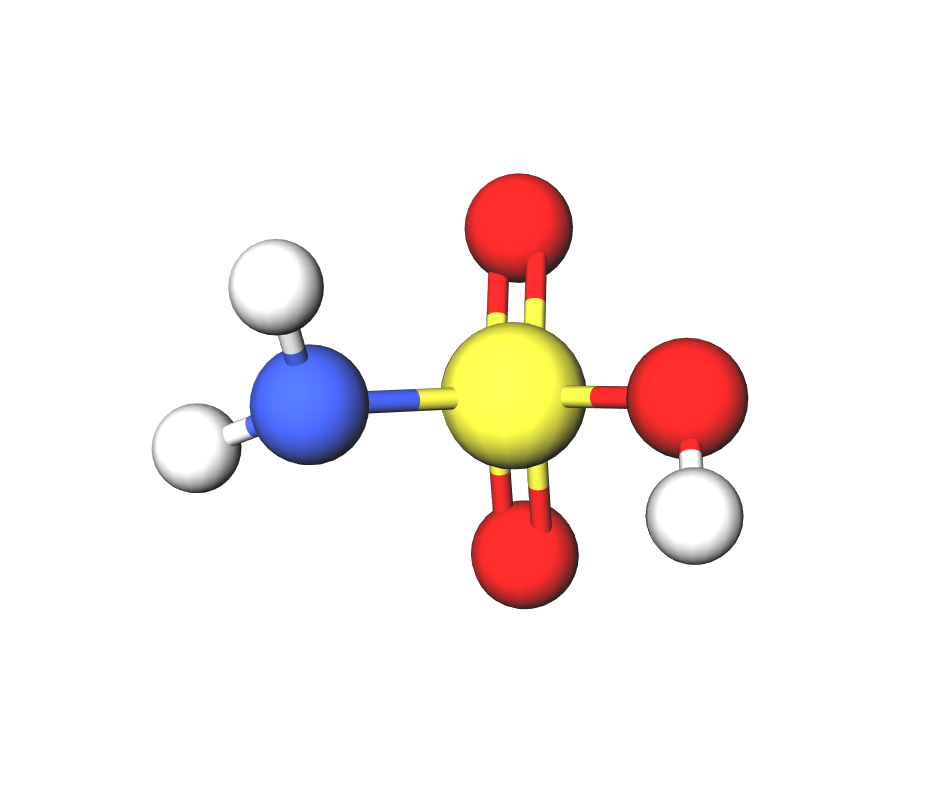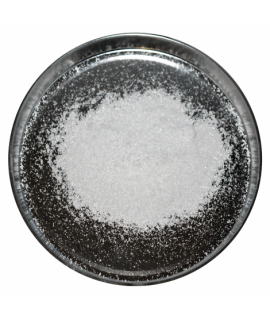SULFAMIC ACID 99%, kg
5.95 €
CHEM060
Sulfamic acid, CAS 5329-14-6, amidosulfinic acid, INCI SULFAMIC ACID, sulfamidine acid, amidosulfonic acid.
Parameter | Attribute |
Sulfamic acid | Amidosulfonic acid, amidosulfitic acid, sulphamic acid |
Formula | H3NSO3 |
Structure |   |
IUPAC | Sulfamic acid |
INCI | SULFAMIC ACID |
CAS | 5329-14-6 |
Molar mass | 97,10 g/mol |
Density | 2,15 g/cm3 |
Solubility | In water: 12.80% - 0 °C; 17.57% - 20 °C; 22.77% - 40 °C; 0.1667% in formamide 25 °C; 0.0412% in methanol 25 °C; 0.0167% in ethanol (2% benzene) prie 25 °C; 0.0040% in acetone 25 °C; 0.0001% in ether 25 °C |
Sulfamic acid, also known as amidosulfonic acid or sulfamic acid, with the formula NH2SO3H, is a white crystalline powder which is non-hygroscopic. Sulfamic acid is soluble in water and formamide, with low solubility in methanol, ether, acetone and concentrated sulfuric acid. It is stable at room temperature for a long time, but at higher temperatures strong hydrolysis starts in solution. Sulfamic acid solutions cause less corrosion on metal surfaces compared to mineral acids, e.g. Sulfuric acids are less acidic than hydrochloric or sulfuric acids.
In the cleaning industry, sulfamic acid is used as a very effective descaling agent in both industrial and domestic cleaning. It is commonly used for descaling heating boilers, heat exchangers, sanitary surfaces and toilets. It helps to remove hard water scale, protein residues, beer scale, milk scale, rust and copper scale. Sulfamic acid is not effective against silicate and calcium phosphate deposits. This acid forms soluble salts of calcium and iron ions, is low in toxicity, low in harmfulness and is therefore often used in the food industry. It is used for descaling and cleaning coffee and espresso machines.
When used as a construction residue remover to remove sealant from tile floors or joints, a solution of 8-10% (80-100g per liter of water) is made and applied to the surface with a cloth or brush and left for a few minutes. If necessary, rub with a brush and wipe/rinse with clean water. If cleaning around colored mortar or putty, it is recommended to use a weaker solution of about 2% (20g per liter of water) to reduce the risk of color fading.
When used as a decalcifier, a 10% solution is used. Sulfamic acid is safe to use on steel, iron, glass and wood surfaces, and can be used with caution on copper, aluminium or galvanized surfaces. Corrosion inhibitors are commonly used in addition to sulfamic acid-based products. Cleaning can be done either by soaking or by circulation. The prepared solution is applied to the surface with a cloth or brush and left for a few minutes. If necessary, rub with a brush and wipe/rinse with clean water.
For use as a descaler in heating systems, a 10-15% circulating solution is made. It is recommended to drain the coolant and fill the system with clean water before flushing. Circulation is carried out with water at room temperature or up to 60°C for a stronger cleaning effect. It is important not to overheat, as the sulfamic acid will then hydrolyze and cease to function. Repeated flushing may be necessary if the system is heavily fouled. After cleaning, a flushing of the system is necessary to remove residual lime scale. A 10-20% solution shall be used for rust removal.
In the metalworking industry, sulfamic acid is used to extract metal sulfamates, which are highly soluble in electrolytes. Sulfamates of cadmium, cobalt, nickel, lead, silver and radium are bright and dense. Lead sulfamate is used in lead purification where particularly high lead purity is required. Sulfamic acid in the ionic state is used to form nickel coatings.
In the paper industry, sulfamic acid inhibits the hardening of paper by temperature rise through chlorination and hydrochloric acid treatment. It inhibits fading of paper at higher temperatures and at lower pH without loss of strength.
In horticulture, sulfamic acid and its salts are used as a herbicide to control the growth of unwanted herbs/plants such as Japanese knapweed (Fallopia japonica), Equisetum (Equisetum), Aegopodium (Aegopodium podagraria), Rhododendron (Rhododendron ponticum), Hedera (Hedge ivy), Senecio (Senecio), Armillaria (Stumpweed), and others.
In the food industry, sulfamic acid is used as a catalyst in the production of sweeteners, such as It is used as a sweetening agent in the production of sweeteners such as cyclamates, acefulfam compounds, etc.
Other uses: constituent in quenching liquids, catalyst in esterification processes, coagulant in formaldehyde rubbers, in the production of nitric oxide by reaction with nitric acid, in the manufacture of pharmaceuticals, in the production of enzymes and in the neutralization of chlorinated cleaners.
Important: Add the item to your basket, fill in the recipient's details and confirm your order. Thank you!
To save your precious time, we will deliver your order to your address at a time convenient for You!
*- The pictures of the goods may not correspond to the actual appearance, color, assembly or shape of the goods and their packaging. The information in the product description is of a general nature and may not correspond to the information on the packaging of the product and may not be the exact use of the product. The information given on the stocks and prices of goods may, in certain cases, differ from the actual prices and stocks of goods
Signal word: Warning |
Hazard icons:
|
Danger phrases: H315 Irritating to skin H319 Causes severe eye irritation H412 Harmful to aquatic organisms, causes long-term effects. |
Precautionary statements: P264 Wash hands thoroughly after use. P273 Keep out of the environment. P280 Wear protective gloves/protective clothing/eye protection/face protection. P305+P351+P338 In case of contact with eyes: wash gently with water for several minutes. Remove contact lenses if they are present and can be easily done. Continue washing eyes. P337+P313 If eye irritation persists: seek medical advice. P302 + P352 IN CASE OF CONTACT WITH SKIN: wash with plenty of soap and water. P332 + P313 In case of skin irritation: seek medical advice. P362 Remove contaminated clothing and wash before putting it back on. P501 Dispose of contents/container in accordance with local regulations. |
CHEM060
Related products
(8 other products in the same category)











